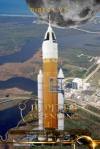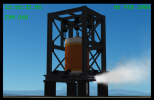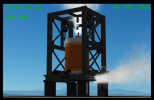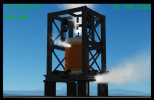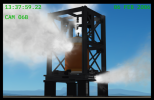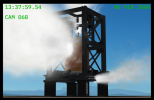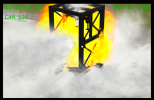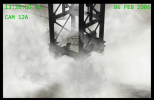Chapter 0: A Goldmine
Hey all. I have recently been motivated and inspired to finally get around to writing that space story I've always wanted to write. Between rediscovering an old rocket (and subsequently realizing I quite enjoyed its looks), and being frustrated with the now impossibility of a 2024 lunar return, in March, I threw out the idea to a small few of a new timeline. This would be a timeline where we return to the Moon before 2020, where there are no commercial lander shenanigans, where SLS isn't several years late (still love SLS, my baby), a timeline where, in fact, SLS is not needed at all, because something else was already on the horizon...
So. A quick few things before we begin.
1) While I try to maintain realism, things that I find just cool enough may get enough points to still make it in, even if they're slightly unrealistic.
2) Similarly, while I try to back up my work with research, I can only do so much. Cut some slack.
3) In the same vein as 2, I always aim to bring my best work. Have patience, and forgive any errors.
4) This is my work. If you'd like to use it, borrow it, modify it, whatever, please message me, and if you receive permission, credit me. I'll be doing the same for anything I borrow, modify, or use.
To that end! The following 'doc' features images and formatting that has either been modified or taken from the following NASA documents.
Images (modified and unmodified):
- After LM: NASA Lunar Lander Concepts Beyond Apollo
- Safer, Simpler, Sooner - Than Ares
Formatting:
- Human Exploration of Mars Design Reference Architecture 5.0
Additionally, a big thank you to defconh3ck of Proxima fame for help with the title, reviewing the doc, and being a continued soundboard for ideas. I know I'm not the first to receive help, so it is appreciated all the more. Their work is super awesome, so check it out if you haven't already.
And finally, a HUGE thank you to AstroEvada for the Jupiter patch! They did this off of a very blurry screenshot from the Safer Simpler pdf, and just for kindness sake! Expect to see it a lot. I must say, I am quite fond of it...
If you'd also like to contribute, message me. I'd be honored!
Now, with that out of the way, I must say one more thing (just in case).
The following document is a work of fiction. It does not exist. I made it, and therefore it has not been taken from any NASA archives. Alright? Good.
NOW. Let us begin.
Been a while. This time I've got a new doc, leaked straight out of NASA. This one's a goldmine. I have no clue how they're going to get the funding for this through Congress, even though they said Jupiter would be significantly cheaper. Excited to see where this goes. I'll have something else in the next few weeks again- my informant says it's being finished up. Until next time. - A.
______________________________________________________________________________________________________
NASA/SP–2008–738
Human Lunar Exploration Architectures

July 17, 2008
Lunar Architecture Steering Group
NASA Headquarters
John C. Barns, editor
NASA Johnson Space Center, Houston, Texas
The NASA Authorization Act of 2005 called NASA to “develop a sustained human presence on the Moon, including a robust precursor program, to promote exploration, science, commerce, and United States preeminence in space, and as a stepping-stone to future exploration of Mars and other destinations.” In support of these goals, the Exploration Systems Architecture Study (ESAS) was carried out in an effort to define the launch vehicles of the program that could carry out such an objective. Similarly, the Lunar Architecture Team (LAT) studied methods of Lunar surface exploration as part of preparation for crewed Mars missions.
Since then, the ever increasing scope, scale, and thus cost of the vehicles originally outlined in ESAS has caused NASA to pivot to Jupiter DIRECT, to allow the Lunar program to be delivered on time, and on budget. To this end, the LAT has reconvened as the Lunar Architecture Steering Group (LASG) to reassess the concepts originally outlined, and to adapt them for the new vehicle, while still maintaining as many of the original goals as outlined.
The switch to Jupiter DIRECT brought a new motto to NASA: Safer, Simpler, Sooner. These ideas are allowing the Administration to better pursue exploration efforts, by refocusing on what was originally important to ensure the program is able to make it to the operational phase. These cultural changes have been adapted to LASG, and were kept in mind when reevaluating the originally outlined concepts.
LASG now presents these refined concepts, confident that they hold the potential to provide the United States with Lunar access before 2020, while maintaining cost-effectiveness and safety, and laying strong foundations for future human exploration of deep space.
2 DIRECT Capabilities
Jupiter DIRECT, even in its largest configuration, 244, will not have the TLI performance of the former Ares V rocket. However, the Constellation program required two launches to complete the lunar stack for TLI; Jupiter DIRECT will similarly require two launches, and in this manner it matches Ares V’s lunar performance.
DIRECT also, through this methodology, could allow for large hardware aggregation in Cislunar space. The dual launches also provide a framework by which large scale probes, telescopes, and other instruments may be sent to other bodies in the Solar System.
STS ET production showed that Michoud Assembly Facility could produce nearly 12 tanks a year at peak rates, before running into storage issues. While largely similar to the ET, the addition of Jupiter’s engine section does increase production time slightly. Peak production rates are expected to reach 8 cores a year, after an approximately 8-year ramp up phase following the initial three flights. The Dual Launch architecture can thus support 4 lunar missions each year. Some studies have indicated a possibility to bring partial reuse to Jupiter, allowing increased flight rates of up to 12 a year. While current projections do not show this to be a critical need of the Lunar and Martian architectures currently under study, the possibility remains open.
Jupiter DIRECT, while simpler, will allow the same mission classes and profiles as the Ares family of launch vehicles. DIRECT additionally allows flex capability to help build Earth SOI infrastructure, and stay sustainable into the future.
3 Lunar Architectures
Prior to down selection and refinement of architectures, LASG allowed a period to introduce any new possibilities that may have arisen with the final selection of Jupiter 244 as the Lunar SHLLV. LASG noted one architecture in particular suggesting the possibility of using a ‘single stack’ Jupiter 244 for initial landings.
Such a mission would involve co-manifesting a lander very similar in weight and size to the Apollo LEM on a Jupiter 244 with Orion. This lander was notionally referred to as the Light Lunar Lander (LLL) within the study. While the J244 variant is expected to be able to place a payload of approximately 41 mT through TLI, and the combined Orion-LLL stack was expected to weigh no more than 40 mT, neither LLL nor Orion would have the performance to perform LOI and their other respective functions. Thus, this plan was scrapped from becoming the “Phase 0” of the 2-Phase architecture.
Instead, both 1-Phase and 2-Phase architectures require dual launches, in order to properly work with the capabilities of Jupiter. To this end, the ‘Staged TLI’ method from the original Jupiter proposal has been scrapped as well- it did not offer substantially better payload capabilities but forced increased cost through complexification of logistics and vehicles. The LASG has decided to use the 244 configuration Jupiter as is- without additional stages or multiple radically different kinds of lunar landers. It is worth noting that early on, Lunar missions may overlap and yield to ISS resupplies and crew rotations until Commercial partners take over, expected to occur in 2013 and 2017 respectively.
In the end this proves beneficial by forcing a large usable payload mass and volume for either option, which directly supports the goal of a sustainable lunar outpost. Both proposals also include a Lunar Logistics Staging Outpost (LLSO). Such outposts, and the priority focus on Lunar activities through 2020, will allow adequate testing and staging grounds for Mars, and support the extension of “Safer, Simpler, Sooner” to the Mars program.
3.1 1-Phase
Operationally, 1-Phase’s first lunar missions begin with launch of a JUS-T, which is met hours to days later by the Lunar Stack. The Stack is refueled, and its JUS performs TLI, as well as most of LOI. CargoStar finishes LOI, and Stack rendezvous with LLSO. CargoStar performs the surface sortie from LLSO, refuels on Surface, and returns crew to LLSO. CEV returns the crew to Earth.

Fig. 1: 1-Phase’s mission architecture. Lander image is a placeholder.
1-Phase is unique in that it focuses on the slow long term aggregation of assets. The return to the moon is delayed in favor of increased short term LEO support. 1-Phase uses CargoStar (See Section 4.1). Prior to the Lunar return, a series of Jupiter launches, both crewed and uncrewed, would construct two additional stations: a small LEO outpost to later serve as an orbital port, and the aforementioned LLSO. The latter would be complete by 2016 and serve as a staging point for Lunar return in 2018, while the former would begin construction in 2014, and continue slow construction as launch cadence and schedule allows, through 2024. As outlined in Section 3, Lunar Focus would give LLSO and Lunar sortie missions priority through 2020.
3.2 2-Phase
A. Similar to 1P, in Phase One of the 2-Phase proposal, the lunar stack rendezvouses in LEO with a JUS-T to refuel. The Lunar stack’s JUS performs TLI, LAST finishes LOI, and performs the surface sortie. CEV returns the crew.

Fig. 2: 2-Phase’s mission architecture for its first Phase. Lander image is a placeholder.
Phase One begins the practice of large volume on-orbit cryogenic transfer, to gain experience and perfect reliability and safety of systems prior to Phase Two and future Martian architectures. Additionally, it builds confidence in LAST and the deep-space capabilities of the CEV.
B. For Phase Two of 2-Phase, a single Jupiter launches CEV; the Lunar stack (if on JUS) refuels from LEO depot, JUS/JUS-L performs TLI and LOI, CEV rendezvous with LLSO. LAST performs surface sortie from LLSO, refuels on Surface and returns crew to LLSO. CEV returns crew to Earth. This mission format is flexible to many specific mission payloads and types.

Fig. 3: 2-Phase’s mission architecture for its second Phase. Lander image is a placeholder.
Phase Two involves a number of logical upgrades to enhance reusability and sustainability of the system. The LEO tanker is replaced by a depot serviced by Commercial and International partners. LAST serves as a ferry between LLSS and the surface zones. LAST-U ferries cargo, delivered with CEV. For larger cargo, a CSM provides basic power, maneuvering capability, and LOI/rendezvous propellant and propulsion, as outlined in Section 4.4C.
3.3 Infrastructure Advancement
In space reuse of as many elements as possible will provide a strong foundation for a future cis-lunar economy. JUS will be designed with this purpose and capability in mind from the get go, allowing extremely easy reuse via Lunar or LEO refueling. JUS may serve as a first generation cislunar tug in the sustainable long term phases of both outlined architectures. Similarly, their respective landers may serve as first generation lunar shuttles. Together with the slow construction of small outposts, the establishment of a foundation for Earth SOI space infrastructure is made easy, through the use of dual purpose or easily evolvable hardware. The visions LASG has outlined here finally fulfill the original visions of Von Braun and others at NASA during the 60’s, for a fraction of the cost.
4 Landers and Spacecraft
Due to the different timetables and slightly different initial requirements of the two Architectures, LASG has selected and adapted two pre-Altair lander concepts that each suit the needs of one of the Architectures. This section outlines those lander selections, as well as basic proposals for other required spacecraft and variants.
For the lander for 1-Phase, LASG selected a design from the Altair lineage, which, while retaining Altair’s robust design, offered greater potential, and could properly utilize the long lead times of 1P. LASG found Langley's CargoStar (0609-LLLPS-LaRC-A) capable of meeting these requirements, with some adaptation. Its low flatbed cargo bay enables easy access to payloads, unlike on landers like Altair or the 2P’s LAST. Additionally, the horizontal configuration that allows this enables CargoStar to carry more propellant for the same diameter, by simply lengthening the tanks, without impacting any other lunar operations.
As discussed in Section 3.1, CargoStar’s increased capabilities relative to Altair do not necessarily offer the ability to meet the ‘Sooner’ part of the DIRECT philosophy; LASG suggests targeting a Lunar return in 2017, rather than 2014, if CargoStar is selected, so that there is ample time and lower peak funding to ensure completion and on time delivery of the lander. Additionally, this extra time, and the fact that CargoStar would be delivered in the Crew Ferry variant as a result (See Section 4.3) would require less long term funding post-delivery to reach sustainability for the architecture.

Fig. 4: NASA Langley 0609-LLPS-LaRC-A
CargoStar would be 8.2 meters in diameter, but due to its launch perpendicular to its operational ‘Up’ axis, it is 8.8 meters tall on the Lunar surface. During launch, it would be 10 meters tall; 10 meters long on the Lunar surface. CargoStar would use LH2/LOX propellants. Unlike LAST, it would use 4 downrated RL-10s as its propulsion, for both Descent and Ascent. One of these engines is proposed as the LAST ascent engine. CargoStar’s increased propellant load compared to Altair means that it is more than capable of performing some of LOI, and still performing the surface sortie in a single stage.
4.2 2-Phase Lander
Similar to the process used to select the lander proposal for 1P, LASG looked to the past to find a concept with some development that could be effectively produced without the size problems plaguing the late Altair, and delivered in a much shorter time frame. LASG identified the 0810-BAA-1 concept from Northrop Grumman as being suitable for the task. This concept would become the Lunar Adaptable Surface Transport (LAST) for 2P.
LAST would have an 8.4 meter descent stage, slightly smaller than Altair’s 8.8 meters. Much like Altair, it would use a combined hab/ascent stage. The airlock would be fixed to the descent stage. Their configuration and the descent stage’s size reduction reduce the overall height to 8.5 meters instead of 9.7 meters.
Altair was vastly overbuilt due to the need to perform all of LOI; this need, while still
existent, is reduced significantly through orbital refueling of JUS, enabling it to perform part of LOI.

Fig. 5: Northrop Grumman 0810-BAA-1
LAST would also retain use of LOX/LH2 propellants. This presents LAST with a unique new opportunity: by refilling propellant on the Lunar surface, a subtype of LAST is able to conduct a full sortie to LLS and return with a single stage. The Ascent and Descent engines are variants of RL-10 that are downrated and significantly uprated respectively. The Ascent engine is shared with CargoStar.
4.3 Lander Variants
LAST and CargoStar both provide a design easily morphed into several variants. Both landers would include a Crew Ferry subtype, as well as uncrewed Cargo and Tanker subtypes. It is worth noting that for these landers, modification does not necessarily mean additions to an already built vehicle, but fundamental design changes and thus production line changes as well, much like the many variants of commercial jets. All variants are Single Stage, possible due to the extra margin afforded by the removal of the need to perform some of LOI, as discussed in Section 3.2B. It is worth noting that CargoStar is delivered in single stage configuration and does not need further modification to fit this requirement. (See Section 3.1) Additionally, further development may indicate a requirement for an additional Transfer Tug to ferry LAST or CargoStar from NRHO to LLO.
A. The Crew Ferry variant would require the removal of all ascent stage hardware that is only necessary for ascent. This includes the ascent engine and associated fuel lines, as well as the possible removal of the ascent tanks. A small extension to the Descent Stage barrel would ensure proper fuel margins, which may negate this need. The separation hardware for the Ascent Module from the airlock would also need removal, and it would be permanently fixed to the descent stage. The final large modification would be removal of the Ascent Engine exhaust deflector panels. Power would be supplied by an enlarged battery bank and fuel cells.
B. The uncrewed Cargo variant would similarly require removal of the Ascent Engine exhaust deflector panels, but would require removal of the entire ascent stage. In its place would sit a lightweight truss supporting a platform for universal cargo mounting, as well as a small crane. To facilitate long duration lunar stays between potential uses, a singular deployable solar panel and an enlarged battery bank provide power. During hibernation the bank and panel would only power critical systems.
C. The Tanker variant would include nearly all of the modifications of the Cargo variant, but would include a permanently mounted LH2/LOX tank. To combine costs, development, and production resources, the Tanker variant could instead feature the tank as a payload of Cargo, which is operationally never removed. This would reduce the tank payload slightly, as it would maintain the cargo deck, but this loss should be minimal. Tanker flights from the Lunar surface would have to be fast, as long term cryogenic storage equipment is heavy and only basic equipment would be mounted on the Tanker.
4.4 Support Spacecraft
Development of the following vehicles is critical for the operations of both Lunar Architectures. LASG recommends a JUS Tanker, a JUS Depot, and a Cargo Service Module (CSM). These vehicles, together with commercial partners, enable the establishment of a routine and sustainable Cislunar Transport Network.
A. The JUS Tanker (JUS-T) is similar to the Lander Tanker variants. A large tank would be affixed as the payload of JUS-T. Propellant lines would be connected to the tanks of JUS, effectively creating an extended JUS with minimal modifications. Tanks could be manufactured in the JUS Michoud assembly lines. A standard JUS already contains the minimal hardware required for fuel transfer, including a temporary docking mechanism, propellant pumps, and the propellant transfer line mating plate. Ullage for transfer would come from bursts of RCS.
B. The JUS Depot (JUS-D) is nearly identical to JUS-T, but features a new propellant payload tank approximately 1.5 times larger, large CEV-derived solar arrays, long duration cooling equipment, and a large deployable sunshield. The increased propellant volume would allow it to refuel nearly 3 standard JUSs. It would be launched almost empty, with a propellant payload of approximately ⅙ of the total propellant payload tank volume. As with all JUS variants, it is equipped with a docking mechanism, fuel transfer pumps, and a fuel transfer line mating plate. Transfer would be facilitated by bursts of RCS. Further modifications would allow the long term permanent mating of multiple JUS-D to create larger propellant reserves.
C. The Cargo Service Module is a small service module derived from the CEV Service Module to enable long duration transfer and docking of payloads which do not possess the hardware for such activities themselves. Due to decreased power requirements, it has only 1 of the solar arrays typically mounted on CEV. It also removes the CEV Command Module protection and separation mechanism, in favor of a lighter weight Payload Truss. Additional life support hardware is removed, along with any associated lines running through the CM Umbilical Latch. The CM Latch is instead a plate mounted on the truss that is easily adaptable to fit a variety of payloads during manufacture, all the way through payload integration.
5 Summary
The two Lunar Architectures LASG has outlined in this document represent the near final evolutions of the work started during Constellation, and two viable paths that may effectively be carried out today in support of NASA and the United State’s future goals, namely remaining the leader in space exploration. LASG will continue to analyze, then select and refine, these architecture concepts for presentation to Congress before the end of FY2008. It is recommended that work then commence on the required vehicles with utmost haste. Speed, in addition to the extreme economization of DIRECT, is key to secure the program, and National leadership interests, well into the future. With Congressional approval, LASG is confident NASA will achieve a return to the Moon before 2020, as originally desired under Constellation, and lay significant groundwork for future voyages into the Solar System.
____________________________________________________________________________________________________________________________________________________________
To be continued...
So. A quick few things before we begin.
1) While I try to maintain realism, things that I find just cool enough may get enough points to still make it in, even if they're slightly unrealistic.
2) Similarly, while I try to back up my work with research, I can only do so much. Cut some slack.
3) In the same vein as 2, I always aim to bring my best work. Have patience, and forgive any errors.
4) This is my work. If you'd like to use it, borrow it, modify it, whatever, please message me, and if you receive permission, credit me. I'll be doing the same for anything I borrow, modify, or use.
To that end! The following 'doc' features images and formatting that has either been modified or taken from the following NASA documents.
Images (modified and unmodified):
- After LM: NASA Lunar Lander Concepts Beyond Apollo
- Safer, Simpler, Sooner - Than Ares
Formatting:
- Human Exploration of Mars Design Reference Architecture 5.0
Additionally, a big thank you to defconh3ck of Proxima fame for help with the title, reviewing the doc, and being a continued soundboard for ideas. I know I'm not the first to receive help, so it is appreciated all the more. Their work is super awesome, so check it out if you haven't already.
And finally, a HUGE thank you to AstroEvada for the Jupiter patch! They did this off of a very blurry screenshot from the Safer Simpler pdf, and just for kindness sake! Expect to see it a lot. I must say, I am quite fond of it...
If you'd also like to contribute, message me. I'd be honored!
Now, with that out of the way, I must say one more thing (just in case).
The following document is a work of fiction. It does not exist. I made it, and therefore it has not been taken from any NASA archives. Alright? Good.
NOW. Let us begin.
. . .
Been a while. This time I've got a new doc, leaked straight out of NASA. This one's a goldmine. I have no clue how they're going to get the funding for this through Congress, even though they said Jupiter would be significantly cheaper. Excited to see where this goes. I'll have something else in the next few weeks again- my informant says it's being finished up. Until next time. - A.
______________________________________________________________________________________________________
NASA/SP–2008–738
Human Lunar Exploration Architectures
July 17, 2008
Lunar Architecture Steering Group
NASA Headquarters
John C. Barns, editor
NASA Johnson Space Center, Houston, Texas
____________________________________________________________________________________________________________________________________________________________
1 IntroductionThe NASA Authorization Act of 2005 called NASA to “develop a sustained human presence on the Moon, including a robust precursor program, to promote exploration, science, commerce, and United States preeminence in space, and as a stepping-stone to future exploration of Mars and other destinations.” In support of these goals, the Exploration Systems Architecture Study (ESAS) was carried out in an effort to define the launch vehicles of the program that could carry out such an objective. Similarly, the Lunar Architecture Team (LAT) studied methods of Lunar surface exploration as part of preparation for crewed Mars missions.
Since then, the ever increasing scope, scale, and thus cost of the vehicles originally outlined in ESAS has caused NASA to pivot to Jupiter DIRECT, to allow the Lunar program to be delivered on time, and on budget. To this end, the LAT has reconvened as the Lunar Architecture Steering Group (LASG) to reassess the concepts originally outlined, and to adapt them for the new vehicle, while still maintaining as many of the original goals as outlined.
The switch to Jupiter DIRECT brought a new motto to NASA: Safer, Simpler, Sooner. These ideas are allowing the Administration to better pursue exploration efforts, by refocusing on what was originally important to ensure the program is able to make it to the operational phase. These cultural changes have been adapted to LASG, and were kept in mind when reevaluating the originally outlined concepts.
LASG now presents these refined concepts, confident that they hold the potential to provide the United States with Lunar access before 2020, while maintaining cost-effectiveness and safety, and laying strong foundations for future human exploration of deep space.
2 DIRECT Capabilities
Jupiter DIRECT, even in its largest configuration, 244, will not have the TLI performance of the former Ares V rocket. However, the Constellation program required two launches to complete the lunar stack for TLI; Jupiter DIRECT will similarly require two launches, and in this manner it matches Ares V’s lunar performance.
DIRECT also, through this methodology, could allow for large hardware aggregation in Cislunar space. The dual launches also provide a framework by which large scale probes, telescopes, and other instruments may be sent to other bodies in the Solar System.
STS ET production showed that Michoud Assembly Facility could produce nearly 12 tanks a year at peak rates, before running into storage issues. While largely similar to the ET, the addition of Jupiter’s engine section does increase production time slightly. Peak production rates are expected to reach 8 cores a year, after an approximately 8-year ramp up phase following the initial three flights. The Dual Launch architecture can thus support 4 lunar missions each year. Some studies have indicated a possibility to bring partial reuse to Jupiter, allowing increased flight rates of up to 12 a year. While current projections do not show this to be a critical need of the Lunar and Martian architectures currently under study, the possibility remains open.
Jupiter DIRECT, while simpler, will allow the same mission classes and profiles as the Ares family of launch vehicles. DIRECT additionally allows flex capability to help build Earth SOI infrastructure, and stay sustainable into the future.
3 Lunar Architectures
Prior to down selection and refinement of architectures, LASG allowed a period to introduce any new possibilities that may have arisen with the final selection of Jupiter 244 as the Lunar SHLLV. LASG noted one architecture in particular suggesting the possibility of using a ‘single stack’ Jupiter 244 for initial landings.
Such a mission would involve co-manifesting a lander very similar in weight and size to the Apollo LEM on a Jupiter 244 with Orion. This lander was notionally referred to as the Light Lunar Lander (LLL) within the study. While the J244 variant is expected to be able to place a payload of approximately 41 mT through TLI, and the combined Orion-LLL stack was expected to weigh no more than 40 mT, neither LLL nor Orion would have the performance to perform LOI and their other respective functions. Thus, this plan was scrapped from becoming the “Phase 0” of the 2-Phase architecture.
Instead, both 1-Phase and 2-Phase architectures require dual launches, in order to properly work with the capabilities of Jupiter. To this end, the ‘Staged TLI’ method from the original Jupiter proposal has been scrapped as well- it did not offer substantially better payload capabilities but forced increased cost through complexification of logistics and vehicles. The LASG has decided to use the 244 configuration Jupiter as is- without additional stages or multiple radically different kinds of lunar landers. It is worth noting that early on, Lunar missions may overlap and yield to ISS resupplies and crew rotations until Commercial partners take over, expected to occur in 2013 and 2017 respectively.
In the end this proves beneficial by forcing a large usable payload mass and volume for either option, which directly supports the goal of a sustainable lunar outpost. Both proposals also include a Lunar Logistics Staging Outpost (LLSO). Such outposts, and the priority focus on Lunar activities through 2020, will allow adequate testing and staging grounds for Mars, and support the extension of “Safer, Simpler, Sooner” to the Mars program.
3.1 1-Phase
Operationally, 1-Phase’s first lunar missions begin with launch of a JUS-T, which is met hours to days later by the Lunar Stack. The Stack is refueled, and its JUS performs TLI, as well as most of LOI. CargoStar finishes LOI, and Stack rendezvous with LLSO. CargoStar performs the surface sortie from LLSO, refuels on Surface, and returns crew to LLSO. CEV returns the crew to Earth.
Fig. 1: 1-Phase’s mission architecture. Lander image is a placeholder.
1-Phase is unique in that it focuses on the slow long term aggregation of assets. The return to the moon is delayed in favor of increased short term LEO support. 1-Phase uses CargoStar (See Section 4.1). Prior to the Lunar return, a series of Jupiter launches, both crewed and uncrewed, would construct two additional stations: a small LEO outpost to later serve as an orbital port, and the aforementioned LLSO. The latter would be complete by 2016 and serve as a staging point for Lunar return in 2018, while the former would begin construction in 2014, and continue slow construction as launch cadence and schedule allows, through 2024. As outlined in Section 3, Lunar Focus would give LLSO and Lunar sortie missions priority through 2020.
3.2 2-Phase
A. Similar to 1P, in Phase One of the 2-Phase proposal, the lunar stack rendezvouses in LEO with a JUS-T to refuel. The Lunar stack’s JUS performs TLI, LAST finishes LOI, and performs the surface sortie. CEV returns the crew.
Fig. 2: 2-Phase’s mission architecture for its first Phase. Lander image is a placeholder.
Phase One begins the practice of large volume on-orbit cryogenic transfer, to gain experience and perfect reliability and safety of systems prior to Phase Two and future Martian architectures. Additionally, it builds confidence in LAST and the deep-space capabilities of the CEV.
B. For Phase Two of 2-Phase, a single Jupiter launches CEV; the Lunar stack (if on JUS) refuels from LEO depot, JUS/JUS-L performs TLI and LOI, CEV rendezvous with LLSO. LAST performs surface sortie from LLSO, refuels on Surface and returns crew to LLSO. CEV returns crew to Earth. This mission format is flexible to many specific mission payloads and types.
Fig. 3: 2-Phase’s mission architecture for its second Phase. Lander image is a placeholder.
Phase Two involves a number of logical upgrades to enhance reusability and sustainability of the system. The LEO tanker is replaced by a depot serviced by Commercial and International partners. LAST serves as a ferry between LLSS and the surface zones. LAST-U ferries cargo, delivered with CEV. For larger cargo, a CSM provides basic power, maneuvering capability, and LOI/rendezvous propellant and propulsion, as outlined in Section 4.4C.
3.3 Infrastructure Advancement
In space reuse of as many elements as possible will provide a strong foundation for a future cis-lunar economy. JUS will be designed with this purpose and capability in mind from the get go, allowing extremely easy reuse via Lunar or LEO refueling. JUS may serve as a first generation cislunar tug in the sustainable long term phases of both outlined architectures. Similarly, their respective landers may serve as first generation lunar shuttles. Together with the slow construction of small outposts, the establishment of a foundation for Earth SOI space infrastructure is made easy, through the use of dual purpose or easily evolvable hardware. The visions LASG has outlined here finally fulfill the original visions of Von Braun and others at NASA during the 60’s, for a fraction of the cost.
4 Landers and Spacecraft
Due to the different timetables and slightly different initial requirements of the two Architectures, LASG has selected and adapted two pre-Altair lander concepts that each suit the needs of one of the Architectures. This section outlines those lander selections, as well as basic proposals for other required spacecraft and variants.
For the lander for 1-Phase, LASG selected a design from the Altair lineage, which, while retaining Altair’s robust design, offered greater potential, and could properly utilize the long lead times of 1P. LASG found Langley's CargoStar (0609-LLLPS-LaRC-A) capable of meeting these requirements, with some adaptation. Its low flatbed cargo bay enables easy access to payloads, unlike on landers like Altair or the 2P’s LAST. Additionally, the horizontal configuration that allows this enables CargoStar to carry more propellant for the same diameter, by simply lengthening the tanks, without impacting any other lunar operations.
As discussed in Section 3.1, CargoStar’s increased capabilities relative to Altair do not necessarily offer the ability to meet the ‘Sooner’ part of the DIRECT philosophy; LASG suggests targeting a Lunar return in 2017, rather than 2014, if CargoStar is selected, so that there is ample time and lower peak funding to ensure completion and on time delivery of the lander. Additionally, this extra time, and the fact that CargoStar would be delivered in the Crew Ferry variant as a result (See Section 4.3) would require less long term funding post-delivery to reach sustainability for the architecture.
Fig. 4: NASA Langley 0609-LLPS-LaRC-A
CargoStar would be 8.2 meters in diameter, but due to its launch perpendicular to its operational ‘Up’ axis, it is 8.8 meters tall on the Lunar surface. During launch, it would be 10 meters tall; 10 meters long on the Lunar surface. CargoStar would use LH2/LOX propellants. Unlike LAST, it would use 4 downrated RL-10s as its propulsion, for both Descent and Ascent. One of these engines is proposed as the LAST ascent engine. CargoStar’s increased propellant load compared to Altair means that it is more than capable of performing some of LOI, and still performing the surface sortie in a single stage.
4.2 2-Phase Lander
Similar to the process used to select the lander proposal for 1P, LASG looked to the past to find a concept with some development that could be effectively produced without the size problems plaguing the late Altair, and delivered in a much shorter time frame. LASG identified the 0810-BAA-1 concept from Northrop Grumman as being suitable for the task. This concept would become the Lunar Adaptable Surface Transport (LAST) for 2P.
LAST would have an 8.4 meter descent stage, slightly smaller than Altair’s 8.8 meters. Much like Altair, it would use a combined hab/ascent stage. The airlock would be fixed to the descent stage. Their configuration and the descent stage’s size reduction reduce the overall height to 8.5 meters instead of 9.7 meters.
Altair was vastly overbuilt due to the need to perform all of LOI; this need, while still
existent, is reduced significantly through orbital refueling of JUS, enabling it to perform part of LOI.
Fig. 5: Northrop Grumman 0810-BAA-1
LAST would also retain use of LOX/LH2 propellants. This presents LAST with a unique new opportunity: by refilling propellant on the Lunar surface, a subtype of LAST is able to conduct a full sortie to LLS and return with a single stage. The Ascent and Descent engines are variants of RL-10 that are downrated and significantly uprated respectively. The Ascent engine is shared with CargoStar.
4.3 Lander Variants
LAST and CargoStar both provide a design easily morphed into several variants. Both landers would include a Crew Ferry subtype, as well as uncrewed Cargo and Tanker subtypes. It is worth noting that for these landers, modification does not necessarily mean additions to an already built vehicle, but fundamental design changes and thus production line changes as well, much like the many variants of commercial jets. All variants are Single Stage, possible due to the extra margin afforded by the removal of the need to perform some of LOI, as discussed in Section 3.2B. It is worth noting that CargoStar is delivered in single stage configuration and does not need further modification to fit this requirement. (See Section 3.1) Additionally, further development may indicate a requirement for an additional Transfer Tug to ferry LAST or CargoStar from NRHO to LLO.
A. The Crew Ferry variant would require the removal of all ascent stage hardware that is only necessary for ascent. This includes the ascent engine and associated fuel lines, as well as the possible removal of the ascent tanks. A small extension to the Descent Stage barrel would ensure proper fuel margins, which may negate this need. The separation hardware for the Ascent Module from the airlock would also need removal, and it would be permanently fixed to the descent stage. The final large modification would be removal of the Ascent Engine exhaust deflector panels. Power would be supplied by an enlarged battery bank and fuel cells.
B. The uncrewed Cargo variant would similarly require removal of the Ascent Engine exhaust deflector panels, but would require removal of the entire ascent stage. In its place would sit a lightweight truss supporting a platform for universal cargo mounting, as well as a small crane. To facilitate long duration lunar stays between potential uses, a singular deployable solar panel and an enlarged battery bank provide power. During hibernation the bank and panel would only power critical systems.
C. The Tanker variant would include nearly all of the modifications of the Cargo variant, but would include a permanently mounted LH2/LOX tank. To combine costs, development, and production resources, the Tanker variant could instead feature the tank as a payload of Cargo, which is operationally never removed. This would reduce the tank payload slightly, as it would maintain the cargo deck, but this loss should be minimal. Tanker flights from the Lunar surface would have to be fast, as long term cryogenic storage equipment is heavy and only basic equipment would be mounted on the Tanker.
4.4 Support Spacecraft
Development of the following vehicles is critical for the operations of both Lunar Architectures. LASG recommends a JUS Tanker, a JUS Depot, and a Cargo Service Module (CSM). These vehicles, together with commercial partners, enable the establishment of a routine and sustainable Cislunar Transport Network.
A. The JUS Tanker (JUS-T) is similar to the Lander Tanker variants. A large tank would be affixed as the payload of JUS-T. Propellant lines would be connected to the tanks of JUS, effectively creating an extended JUS with minimal modifications. Tanks could be manufactured in the JUS Michoud assembly lines. A standard JUS already contains the minimal hardware required for fuel transfer, including a temporary docking mechanism, propellant pumps, and the propellant transfer line mating plate. Ullage for transfer would come from bursts of RCS.
B. The JUS Depot (JUS-D) is nearly identical to JUS-T, but features a new propellant payload tank approximately 1.5 times larger, large CEV-derived solar arrays, long duration cooling equipment, and a large deployable sunshield. The increased propellant volume would allow it to refuel nearly 3 standard JUSs. It would be launched almost empty, with a propellant payload of approximately ⅙ of the total propellant payload tank volume. As with all JUS variants, it is equipped with a docking mechanism, fuel transfer pumps, and a fuel transfer line mating plate. Transfer would be facilitated by bursts of RCS. Further modifications would allow the long term permanent mating of multiple JUS-D to create larger propellant reserves.
C. The Cargo Service Module is a small service module derived from the CEV Service Module to enable long duration transfer and docking of payloads which do not possess the hardware for such activities themselves. Due to decreased power requirements, it has only 1 of the solar arrays typically mounted on CEV. It also removes the CEV Command Module protection and separation mechanism, in favor of a lighter weight Payload Truss. Additional life support hardware is removed, along with any associated lines running through the CM Umbilical Latch. The CM Latch is instead a plate mounted on the truss that is easily adaptable to fit a variety of payloads during manufacture, all the way through payload integration.
5 Summary
The two Lunar Architectures LASG has outlined in this document represent the near final evolutions of the work started during Constellation, and two viable paths that may effectively be carried out today in support of NASA and the United State’s future goals, namely remaining the leader in space exploration. LASG will continue to analyze, then select and refine, these architecture concepts for presentation to Congress before the end of FY2008. It is recommended that work then commence on the required vehicles with utmost haste. Speed, in addition to the extreme economization of DIRECT, is key to secure the program, and National leadership interests, well into the future. With Congressional approval, LASG is confident NASA will achieve a return to the Moon before 2020, as originally desired under Constellation, and lay significant groundwork for future voyages into the Solar System.
____________________________________________________________________________________________________________________________________________________________
To be continued...
Last edited:
